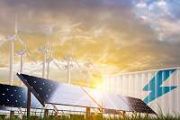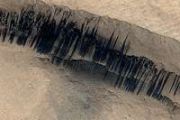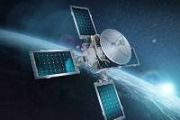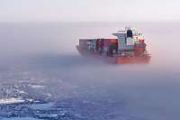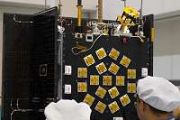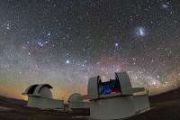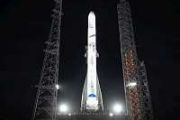
Copernical Team
Radio silence suggests failure of Japan Moon landing
 A Japanese startup attempting the first private landing on the Moon said Wednesday it had lost communication with its spacecraft and assumed the lunar mission had failed.
Ispace said that it could not establish communication with the unmanned Hakuto-R lunar lander after its expected landing time, a frustrating end to a mission that began with a launch from the United States over four months
A Japanese startup attempting the first private landing on the Moon said Wednesday it had lost communication with its spacecraft and assumed the lunar mission had failed.
Ispace said that it could not establish communication with the unmanned Hakuto-R lunar lander after its expected landing time, a frustrating end to a mission that began with a launch from the United States over four months SpaceX delays launch of 46 Starlink satellites
 SpaceX on Tuesday delayed its latest effort to populate the low Earth orbit with Internet communication satellites.
The company announced on Twitter that the launch of 46 new Starlink satellites, originally scheduled for Tuesday morning would be delayed 24 hours as it was now targeting a launch window of 9:40 a.m. EDT on Wednesday from the Vandenberg Space Station in California.
SpaceX on Tuesday delayed its latest effort to populate the low Earth orbit with Internet communication satellites.
The company announced on Twitter that the launch of 46 new Starlink satellites, originally scheduled for Tuesday morning would be delayed 24 hours as it was now targeting a launch window of 9:40 a.m. EDT on Wednesday from the Vandenberg Space Station in California. Fly me to the Moon: Firms lining up lunar landings
 Japan's ispace on Wednesday became the latest company to try, and fail, at a historic bid to put a private lunar lander on the Moon.
Only Russia, the United States and China have made the 384,000-kilometre (239,000-mile) journey and landed safely on the Moon's surface.
Here are some of the companies who have made the journey, or plan missions soon:
- SpaceIL -
In February 2019, t
Japan's ispace on Wednesday became the latest company to try, and fail, at a historic bid to put a private lunar lander on the Moon.
Only Russia, the United States and China have made the 384,000-kilometre (239,000-mile) journey and landed safely on the Moon's surface.
Here are some of the companies who have made the journey, or plan missions soon:
- SpaceIL -
In February 2019, t Scientist lays out plans for international lunar station and 3D luanr printing
 China is proposing to establish a multinational organization to take charge of the construction and operation of the International Lunar Research Station.
Wu Weiren, an academician at the Chinese Academy of Engineering and chief planner of the country's lunar programs, said on Tuesday in Hefei, Anhui province, the organization will be responsible for planning, building and running the luna
China is proposing to establish a multinational organization to take charge of the construction and operation of the International Lunar Research Station.
Wu Weiren, an academician at the Chinese Academy of Engineering and chief planner of the country's lunar programs, said on Tuesday in Hefei, Anhui province, the organization will be responsible for planning, building and running the luna China to launch Tianwen 2 mission to explore asteroid
 HEFEI - China plans to launch the Tianwen 2 mission around 2025 to collect samples from a near-Earth asteroid and explore a comet, a senior space expert said Monday.
The main goal of the Tianwen 2 mission is to send a probe to a near-Earth asteroid coded 2016HO3 to retrieve samples, Zhang Rongqiao, the chief designer of China's planetary exploration program and chief designer of the Tianwe
HEFEI - China plans to launch the Tianwen 2 mission around 2025 to collect samples from a near-Earth asteroid and explore a comet, a senior space expert said Monday.
The main goal of the Tianwen 2 mission is to send a probe to a near-Earth asteroid coded 2016HO3 to retrieve samples, Zhang Rongqiao, the chief designer of China's planetary exploration program and chief designer of the Tianwe China plans to retrieve Martian soil by 2030
 China's Chang'e 5 robotic mission created history when it brought back samples from the lunar surface in 2020, and now, Chinese space scientists have set their sights on another celestial body - Mars.
According to Wu Yanhua, chief designer of China's deep-space exploration programs, the nation plans to bring Martian soil back to Earth around 2030. The mission has been named Tianwen 3, whic
China's Chang'e 5 robotic mission created history when it brought back samples from the lunar surface in 2020, and now, Chinese space scientists have set their sights on another celestial body - Mars.
According to Wu Yanhua, chief designer of China's deep-space exploration programs, the nation plans to bring Martian soil back to Earth around 2030. The mission has been named Tianwen 3, whic China lunar samples gifted to Russia, France
 China has gifted lunar samples retrieved by the Chang'e 5 mission to Russia and France to boost lunar research, according to the China National Space Administration.
The administration announced on Monday that 1.5 grams of lunar samples were presented to Russia during President Vladimir Putin's visit to China in February 2022. In return, Russia gave China a reciprocal amount from the 1970
China has gifted lunar samples retrieved by the Chang'e 5 mission to Russia and France to boost lunar research, according to the China National Space Administration.
The administration announced on Monday that 1.5 grams of lunar samples were presented to Russia during President Vladimir Putin's visit to China in February 2022. In return, Russia gave China a reciprocal amount from the 1970 China releases first panoramic images of Mars
 China published on Monday the first global panoramic images of Mars taken by the country's Tianwen 1 mission.
The color images include the Robinson projection, Mercator projection, azimuthal projection and orthographic projection of the Eastern and Western hemispheres of Mars, with a spatial resolution of 76 meters.
The images were jointly released by the China National Space Adminis
China published on Monday the first global panoramic images of Mars taken by the country's Tianwen 1 mission.
The color images include the Robinson projection, Mercator projection, azimuthal projection and orthographic projection of the Eastern and Western hemispheres of Mars, with a spatial resolution of 76 meters.
The images were jointly released by the China National Space Adminis Pioneering research sheds new light on the origins and composition of planet Mars
 A new study has uncovered intriguing insights into the liquid core at the centre of Mars, furthering understanding of the planet's formation and evolution.
The research, led by the University of Bristol and published in the journal Proceedings of the National Academy of Sciences of the US, reveals the first-ever detections of sound waves travelling into the Martian core. Measurements from
A new study has uncovered intriguing insights into the liquid core at the centre of Mars, furthering understanding of the planet's formation and evolution.
The research, led by the University of Bristol and published in the journal Proceedings of the National Academy of Sciences of the US, reveals the first-ever detections of sound waves travelling into the Martian core. Measurements from NASA extracts oxygen from lunar soil simulant
 As NASA works toward sending astronauts to the Moon through Artemis missions, one of the agency's primary goals is to establish a long-term presence on the lunar surface. Resources like oxygen are crucial building blocks for making that vision a reality. In addition to using oxygen for breathing, it can also be used as a propellant for transportation, helping lunar visitors stay longer and ventu
As NASA works toward sending astronauts to the Moon through Artemis missions, one of the agency's primary goals is to establish a long-term presence on the lunar surface. Resources like oxygen are crucial building blocks for making that vision a reality. In addition to using oxygen for breathing, it can also be used as a propellant for transportation, helping lunar visitors stay longer and ventu 












